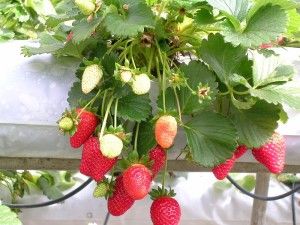Cadiz blending pipeline cuts salt in water
by Wayne Lusvardi | September 4, 2013 8:59 am
California farmers harvest more than 1.7 billion[1] strawberries every year. Reducing the salt content in irrigation water is critical to growing strawberries without “salt blight.”
 [2]“Salt blight” symptoms include [3]“leaf scorch” at the edge of leaves, stunted plant growth, dead roots and plants, and a 50 percent reduction in strawberry crop yields.
[2]“Salt blight” symptoms include [3]“leaf scorch” at the edge of leaves, stunted plant growth, dead roots and plants, and a 50 percent reduction in strawberry crop yields.
A small upstart renewable resources water company in the Mojave Desert of Southern California has found a way to grow strawberries without salt blight, to produce better quality cut flowers for sale in your local market, to reduce corrosion in your hot water heater and appliances, and to save water treatment costs. This private water company might better be called a water ranch or natural water purification blending business; but it is a publicly traded water company on the stock exchange[4].
Its name is Cadiz Inc.,[5] a private land and water resource enterprise with 45,000 acres of land and underground water basins with the storage capacity equivalent to Lake Mead.
A Proposed Water Blending Pipeline
A new report prepared by engineering consulting firm CH2M Hill[6] details how Cadiz proposes to reduce the saline in water coming to Southern Californians. Cadiz plans[7] to convey water from State Water Project California through a 96-mile converted former natural gas pipeline[8] from Kern County to the Cadiz Ranch to blend with water from the Colorado River Aqueduct serving urban Southern California. Cadiz agreed to buy the 96-mile former $200 million gas pipeline for $1 million.
This project is in the preliminary planning stage and would require environmental approval, a connection of Cadiz’s system to the State Water Project, an eventual new pipeline connection to the Colorado River Aqueduct, a water wheeling agreement with the Metropolitan Water District, and contracts to buy the water.
The salinity of the State Water Project water is 275 milligrams per quart of water. Water from the Cadiz aquifer is 300 milligrams per quart. This water would be blended with Colorado River Aqueduct water that ranges from 500 to 800 milligrams in salt content to reduce the saline content. About 50,000 acre-feet of low-salt Cadiz water would be delivered to Southern California water customers in just a few years during Phase 1 of the project. That’s enough water to serve the entire City of Pasadena in Southern California for one year.
Water more than 1,000 milligrams of total dissolved solids is considered too saline for drinking, cooking, gardening, and agricultural irrigation usage. According to the March 2013 report of the Southern California Salinity Coalition[9], “increased salinity is one of the most under-recognized water quality threats in the Southwest.”
Reliability Now More Important Than Cost
The cost of Cadiz water is still to be determined. But more important is the greater reliability of higher quality water that the Cadiz system would provide.
Today, water customers can no longer be guaranteed any more of the availability of high quality water for drinking, irrigating strawberries or watering home garden flowers. This is because they can’t be sure of getting their full allocation of State Water Project water.
It isn’t only strawberries grown in sunny climates that are negatively affected by water salinity.
And home gardening is also affected by the “hardness of water,” which one water department describes as[10] “caused by compounds of calcium and magnesium, and by a variety of other metals.” The standard method of reducing water hardness is to replace calcium and magnesium in the soil with sodium (salt). But salt can be toxic for flowers too.
Toxic Soluble Salt Levels for Selected Flowers
| Flower | Toxic Soluble Salt Level — Parts Per Million |
| Gladiolas | 700 |
| Roses | 200 |
| Mums | 200 |
| Carnations | 200 |
| Source: Kansas State University Department of Horticulture, Forestry and Recreation Uses, Water Quality: Why Is It So Important for Florists[11], March 2000. | |
The next time you buy strawberries at your local market, you may notice that the leaves are not “scorched” or blighted and the fruit doesn’t taste salty. The next time you water roses, gladiolas or carnations in your garden, you will realize that you aren’t exposing the plants to toxic levels of salinity.
The water that flows from your garden spigot will be less likely to be subject to a city order enforced by water police not to water your lawn or flowers because of reductions in imported water. All these benefits come from a water ranch in the Mojave Desert called Cadiz.
BENEFIT/IMPACT CATEGORIES FOR REDUCING WATER SALINITY BY BLENDING
RESIDENTIAL
|
COMMERCIAL
|
AGRICULTURE
|
WATER UTILITIES
|
||
WATER RECYCLING
Industrial |
INDUSTRIAL
|
GROUNDWATER
|
| Salinity Management Study Final Report, Metropolitan Water District and U.S.Department of Interior-Bureau of Reclamation, 1999.[12] | ||
- more than 1.7 billion: http://www.californiastrawberries.com/about_strawberries
- [Image]: http://calwatchdog.com/wp-content/uploads/2013/09/Strawberries-wikimedia.jpg
- symptoms include : http://ucanr.edu/blogs/strawberries-vegetables/index.cfm?tagname=Salinity%20in%20strawberries
- publicly traded water company on the stock exchange: http://topics.nytimes.com/top/news/business/companies/cadiz-inc/index.html
- Cadiz Inc.,: http://cadizinc.com/
- CH2M Hill: http://www.cadizinc.com/downloads/Salts_Econ_Benefits.pdf
- Cadiz plans: http://www.businesswire.com/news/home/20130821005854/en/Cadiz-Project-Provide-8-Million-Annual-Savings
- 96-mile converted former natural gas pipeline: http://www.reuters.com/article/2012/02/29/idUS160130+29-Feb-2012+BW20120229
- March 2013 report of the Southern California Salinity Coalition: http://www.businesswire.com/news/home/20130821005854/en/Cadiz-Project-Provide-8-Million-Annual-Savings
- one water department describes as: http://www.fcwa.org/water/hardness.htm
- Water Quality: Why Is It So Important for Florists: http://www.ksre.ksu.edu/bookstore/pubs/mf2436.pdf
- Salinity Management Study Final Report, Metropolitan Water District and U.S.Department of Interior-Bureau of Reclamation, 1999.: ftp://ftpdpla.water.ca.gov/users/prop50/10024_BayArea/Attach.%208%20Supporting%20Docs/Econ%20Analysis%20Supporting%20Documents/Salinity%20Management%20Study/FullReport.pdf
Source URL: https://calwatchdog.com/2013/09/04/cadiz-blending-pipeline-cuts-salt-in-water/